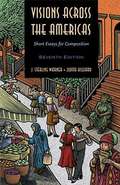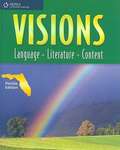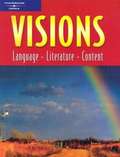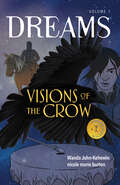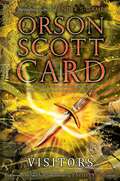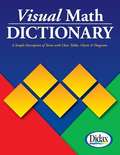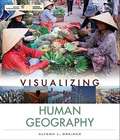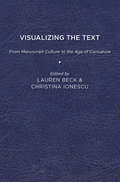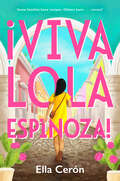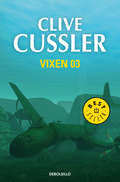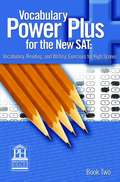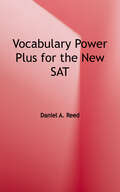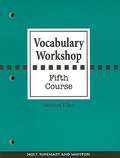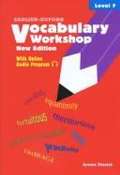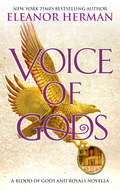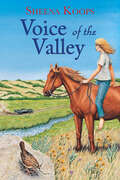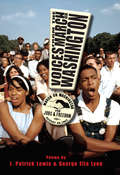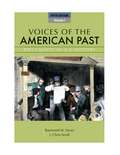- Table View
- List View
Visions Across the Americas: Short Essays for Composition, 7th Edition
by J. Sterling Warner Judith HilliardVISIONS ACROSS AMERICAS is a good fit for developmental writing courses that focus on essay-level writing. This text is also appropriate for some freshman composition programs.
Visions Book A: Language, Literature, Content
by Mary Lou Mccloskey Lydia StackVisions Intro is a highly motivating beginning year course that takes students from pre-literacy and school survival to basic academic skills in listening, speaking, reading, and writing. It provides a seamless transition to Visions A. The carefully designed wraparound Teacher Edition contains a wealth of strategies from teacher modeling to direct instruction for beginners.
Visions Book B: Language, Literature, Content
by Mary Lou Mccloskey Lydia StackUse this book to "grow" your English, to talk about what you write and read. Use it to learn lots of new words and new reading strategies you'll need.
Visions of the Crow (Dreams #1)
by Wanda John-Kehewin&“Your ancestors have called us to help you.&”&“I think y'all have the wrong number.&” Damon Quinn just wants to get through his senior year unscathed. His mom struggles with alcohol and is barely coping with the day-to-day. Marcus and his cronies at school are forever causing Damon trouble. The new girl, Journey, won't mind her own business. To make matters worse, now a mysterious crow is following him everywhere. After he is seized by a waking dream in the middle of a busy street, Damon is forced to confront his mom with some hard questions: Why haven't I met my dad? Where did we come from? Who am I? Damon must look within himself, mend the bond with his mother, and rely on new friends to find the answers he so desperately needs. Travelling through time and space, Damon will have to go back before he can move forward.
Visions of the Crow (Dreams #1)
by Wanda John-Kehewin&“Your ancestors have called us to help you.&”&“I think y'all have the wrong number.&” Damon Quinn just wants to get through his senior year unscathed. His mom struggles with alcohol and is barely coping with the day-to-day. Marcus and his cronies at school are forever causing Damon trouble. The new girl, Journey, won't mind her own business. To make matters worse, now a mysterious crow is following him everywhere. After he is seized by a waking dream in the middle of a busy street, Damon is forced to confront his mom with some hard questions: Why haven't I met my dad? Where did we come from? Who am I? Damon must look within himself, mend the bond with his mother, and rely on new friends to find the answers he so desperately needs. Travelling through time and space, Damon will have to go back before he can move forward.
Visitors: Pathfinder; Ruins; Visitors (Pathfinder #3)
by Orson Scott CardFrom the internationally bestselling author of Ender's Game comes the riveting finale to the story of Rigg, a teenager who possesses a secret talent that allows him to see the paths of people's pasts. <P> In Pathfinder, Rigg joined forces with another teen with special talents on a quest to find Rigg's sister and discover the true depth and significance of their powers. Then Rigg's story continued in Ruins as he was tasked to decipher the paths of the past before the arrival of a destructive force with deadly intentions. Now, in Visitors, Rigg's journey comes to an epic and explosive conclusion as everything that has been building up finally comes to pass, and Rigg is forced to put his powers to the test in order to save his world and end the war once and for all.
Vistas: Introducción a la lengua española
by José A. Blanco Philip Redwine DonleyNIMAC-sourced textbook
Visual Math Dict
by Don Balka Jack BanaThe most accessible and useful guide to math terms and procedures available, this reference has over 600 definitions and scores of additional resources including tables, rules and symbols.
Visualizing Human Geography: At Home in a Diverse World
by Alyson L. GreinerThis book provides environmental scientists with a better understanding of global human geography because of its visual approach. The narrative and concepts are tightly linked to visual elements, including practical examples that highlight the relevance of the concepts. Maps are integrated throughout to help reveal patterns or trends. Divergent views and critical thinking are emphasized. Photographs and other visuals are also included to reinforce the concepts. With this approach, environmental scientists will gain a strong foundation for thinking geographically as they develop the skills for interpreting and analyzing their world.
Visualizing the Text: From Manuscript Culture to the Age of Caricature
by Ann Lewis Michiel Van Groesen Janine Rogers Rachel Schmidt Lauren Beck Cecilia Brain Sandra Sáenz-López Pérez Swann Paradis David McCallam Antoine EcheThis volume presents in-depth and contextualized analyses of a wealth of visual materials. These documents provide viewers with a mesmerizing and informative glimpse into how the early modern world was interpreted by image-makers and presented to viewers during a period that spans from manuscript culture to the age of caricature. The premise of this collection responds to a fundamental question: how are early modern texts, objects, and systems of knowledge imaged and consumed through bimodal, hybrid, or intermedial products that rely on both words and pictures to convey meaning? The twelve contributors to this collection go beyond traditional lines of inquiry into word-and-image interaction to deconstruct visual dynamics and politics—to show how images were shaped, manipulated, displayed, and distributed to represent the material world, to propagate official and commercial messages, to support religious practice and ideology, or to embody relations of power. These chapters are anchored in various theoretical and disciplinary points of departure, such as the history of collections and collecting, literary theory and criticism, the histories of science, art history and visual culture, word-and-image studies, as well as print culture and book illustration. Authors draw upon a wide range of visual material hitherto insufficiently explored and placed in context, in some cases hidden in museums and archives, or previously assessed only from a disciplinary standpoint that favored either the image or the text but not both in relation to each other. They include manuscript illuminations representing compilers and collections, frontispieces and other accompanying plates published in catalogues and museographies, astronomical diagrams, mixed pictographic-alphabetic accounting documents, Spanish baroque paintings, illustrative frontispieces or series inspired by or designed for single novels or anthologies, anatomical drawings featured in encyclopedic publications, visual patterns of volcanic formations, engravings representing the New World that accompany non-fictional travelogues, commonplace books that interlace text and images, and graphic satire. Geographically, the collection covers imperial centers (Great Britain, France, the Netherlands, and Spain), as well as their colonial periphery (New France; Mexico; Central America; South America, in particular Brazil; parts of Africa; and the island of Ceylon). Emblematic and thought-provoking, these images are only fragments of the multifaceted and comprehensive visual mosaic created during the early modern period, but their consideration has far reaching implications.
Visualizing the Text: From Manuscript Culture to the Age of Caricature
by Lauren Beck Christina IonescuThis volume presents in-depth and contextualized analyses of a wealth of visual materials. These documents provide viewers with a mesmerizing and informative glimpse into how the early modern world was interpreted by image-makers and presented to viewers during a period that spans from manuscript culture to the age of caricature. The premise of this collection responds to a fundamental question: how are early modern texts, objects, and systems of knowledge imaged and consumed through bimodal, hybrid, or intermedial products that rely on both words and pictures to convey meaning? The twelve contributors to this collection go beyond traditional lines of inquiry into word-and-image interaction to deconstruct visual dynamics and politics—to show how images were shaped, manipulated, displayed, and distributed to represent the material world, to propagate official and commercial messages, to support religious practice and ideology, or to embody relations of power. These chapters are anchored in various theoretical and disciplinary points of departure, such as the history of collections and collecting, literary theory and criticism, the histories of science, art history and visual culture, word-and-image studies, as well as print culture and book illustration. Authors draw upon a wide range of visual material hitherto insufficiently explored and placed in context, in some cases hidden in museums and archives, or previously assessed only from a disciplinary standpoint that favored either the image or the text but not both in relation to each other. They include manuscript illuminations representing compilers and collections, frontispieces and other accompanying plates published in catalogues and museographies, astronomical diagrams, mixed pictographic-alphabetic accounting documents, Spanish baroque paintings, illustrative frontispieces or series inspired by or designed for single novels or anthologies, anatomical drawings featured in encyclopedic publications, visual patterns of volcanic formations, engravings representing the New World that accompany non-fictional travelogues, commonplace books that interlace text and images, and graphic satire. Geographically, the collection covers imperial centers (Great Britain, France, the Netherlands, and Spain), as well as their colonial periphery (New France; Mexico; Central America; South America, in particular Brazil; parts of Africa; and the island of Ceylon). Emblematic and thought-provoking, these images are only fragments of the multifaceted and comprehensive visual mosaic created during the early modern period, but their consideration has far reaching implications.
Viva Lola Espinoza
by Ella CerónA debut young adult novel that&’s Pride & Prejudice with a dash of magic, about a booksmart teen who spends the summer in Mexico City, meets two very cute boys, attempts to learn Spanish, and uncovers a family secret that changes her life forever.Lola Espinoza is cursed in love. Well, maybe not actually cursed — magic isn't real, is it? When Lola goes to spend the summer with her grandmother in Mexico City and meets handsome, flirtatious Rio, she discovers the unbelievable truth: Magic is very real, and what she'd always written off as bad luck is actually, truly . . . a curse. If Lola ever wants to fall in love without suffering the consequences, she'll have to break the curse. She finds an unlikely curse-breaking companion in Javi, a seemingly stoic boy she meets while working in her cousin's restaurant. Javi is willing to help Lola look into this family curse of hers, and Lola needs all the help she can get. Over the course of one summer — filled with food, family, and two very different boys — Lola explores Mexico City while learning about herself, her heritage, and the magic around us all.
Vixen 03 (Dirk Pitt #4)
by Clive CusslerEn 1954, el vuelo Vixen 03 y su mortífero cargamento, un arma ultrasecreta, no llegan a su misterioso destino. La investigación oficial dictamina que el avión ha caído en el océano. En 1988, Dirk Pitt descubre restos del Vixen 03 en las heladas aguas de un río de Colorado. Parte de su cargamento ha sido sustraído por un grupo terrorista africano con intenciones de provocar una catástrofe en Washington. Pero ni siquiera los terroristas conocen las terribles consecuencias que podrían provocar con su actitud, porque muy pocas personas saben la verdad sobre el cargamento del Vixen 03.
Vocabulary Power Plus for the ACT (Book One)
by Daniel A. ReedVocabulary Power Plus for the ACT will help you: * Introduce students to the ACT test format with ACT-style multiple choice questions * Build student writing skills with practical, ACT-style writing prompts * Reinforce correct grammar usage with ACT-style exercises * Use proven techniques to help students gain skills using word-in-context questions; prefix, suffix, and root practice; inference questions; and critical reading exercises
Vocabulary Power Plus for the New SAT
by Daniel A. ReedYour students will score higher on the SAT once they've used Prestwick House's Vocabulary Power Plus for the New SAT, the only program that addresses all of the revisions in the test without compromising the vocabulary studies students need. Each unit alternates focusing on the critical reading and essay portions of the test with questions focusing on sentence completion, reading comprehension, inference, essay, root practice, and more. Review units ensure your students will remember what they've learned.
Vocabulary Power Plus for the New SAT
by Daniel A. ReedBeginning in 2005, the SAT is implementing major revisions, including: New reading sections; Analogies removed; Multiple-Choice Grammar and Usage Questions; Modified Reading Questions.Vocabulary Power Plus for the New SAT addresses all of the revisions in the test without vocabulary studies. Students will benefit from: Focused prefix, suffix, and root practice; Challenging inference exercises; Detailed critical reading exercises; New SAT-style writing and grammar exercises. Recommended for grade 11
Vocabulary Workshop, Common Core Enriched Edition, Level F
by Jerome Shostak Vicki A. Jacobs Louis P. De AngeloA publisher-supplied textbook
Vocabulary Workshop: Fifth Course
by Norbert ElliotThis book helps readers develop strategies for learning new words on their own; analyse and think about the logic of the sentence and provides opportunity to expand the readers' vocabulary.
Vocabulary Workshop: Level F (New Edition)
by Jerome ShostakPrepare students for the new standardized tests and teach 300 essential vocabulary words per level.
Vocabulary for the College-Bound Student
by Harold Levine Norman Levine Robert T. LevineTo provide meaningful, organized vocabulary improvement for the high school student whose goals may be college admission, a responsible position, or self-improvement.
Voice of Gods
by Eleanor HermanAt nineteen, Ada of Caria yearns to take the Snake Blood throne from her mad older siblings. She seeks the help of a young orphaned girl named Helen, the first True Oracle to have walked the earth in more than three hundred years.Helen may be able to channel the voice of the gods, but she hates her gift and will do anything to get rid of it--even lie to her best friend, Myrtale, the priestess-princess of Epirus who is destined to marry King Philip II of Macedon even though she loves another.And in the shadows lurks a handsome green-eyed stranger who has more at stake--and more to lose--than anyone could possibly imagine.Amid jealousy and heartbreak, torrid affairs and secret rendezvous, it is spoken by the gods that either Helen or Myrtale--newly named Olympias--will carry the destiny of the known world within her womb.The prequel to Legacy of Kings, Voice of Gods traces the intricate web of love and betrayal that led up to the birth of history's most powerful leader, Alexander the Great.
Voice of the Valley
by Sheena KoopsVoice of the Valley is a poetic, multi-layered, coming-of-age story inspired by the controversial flooding of Saskatchewan's Souris Valley. Onja Claibourn is almost fifteen. Her world is one of sage, buffalo bills, brown-eyed susans, cactus, flax, buckbrush, foxtail and orange moss—the world of the valley just beyond the family farm. Old roads twist like a game of snakes and ladders into the valley. Onja and her horse Ginger spend their summer days in exploration. But things begin to change when Onja discovers first an archeological dig and then the startling fact that there is a plan to dam and flood her valley. She cannot contemplate this change to the landscape she loves so much. And when she also discovers sixteen-year-old Etthen, working with the archaeologists, she begins those first faltering footsteps toward a totally unfamiliar landscape—romantic love. Onja Claibourn is a wonderfully complex and very real character—innocent, wise, shy, stubborn, playful, and caring. The other major character in the novel is the prairie landscape itself—huge sky, harsh sun, rolling hills, sweeping fields of grain.
Voices from the March on Washington
by George Ella Lyon J. Patrick LewisThe powerful poems in this poignant collection weave together multiple voices to tell the story of the March on Washington, DC, in 1963. From the woman singing through a terrifying bus ride to DC, to the teenager who came partly because his father told him, "Don't you dare go to that march," to the young child riding above the crowd on her father's shoulders, each voice brings a unique perspective to this tale. <P><P> As the characters tell their personal stories of this historic day, their chorus plunges readers into the experience of being at the march--walking shoulder-to-shoulder with strangers, hearing Martin Luther King Jr.'s famous speech, heading home inspired.
Voices in the Code: A Story about People, Their Values, and the Algorithm They Made
by David G. RobinsonAlgorithms—rules written into software—shape key moments in our lives: from who gets hired or admitted to a top public school, to who should go to jail or receive scarce public benefits. Such decisions are both technical and moral. Today, the logic of high stakes software is rarely open to scrutiny, and central moral questions are often left for the technical experts to answer. Policymakers and scholars are seeking better ways to share the moral decisionmaking within high stakes software—exploring ideas like public participation, transparency, forecasting, and algorithmic audits. But there are few real examples of those techniques in use. In Voices in the Code, scholar David G. Robinson tells the story of how one community built a life-and-death algorithm in an inclusive, accountable way. Between 2004 and 2014, a diverse group of patients, surgeons, clinicians, data scientists, public officials and advocates collaborated and compromised to build a new kidney transplant matching algorithm—a system to offer donated kidneys to particular patients from the U.S. national waiting list. Drawing on interviews with key stakeholders, unpublished archives, and a wide scholarly literature, Robinson shows how this new Kidney Allocation System emerged and evolved over time, as participants gradually built a shared understanding both of what was possible, and of what would be fair. Robinson finds much to criticize, but also much to admire, in this story. It ultimately illustrates both the promise and the limits of participation, transparency, forecasting and auditing of high stakes software. The book’s final chapter draws out lessons for the broader struggle to build technology in a democratic and accountable way.
Voices of the American Past: Documents in U.S. History, Volume I
by Raymond M. Hyser J. Chris ArndtNIMAC-sourced textbook
